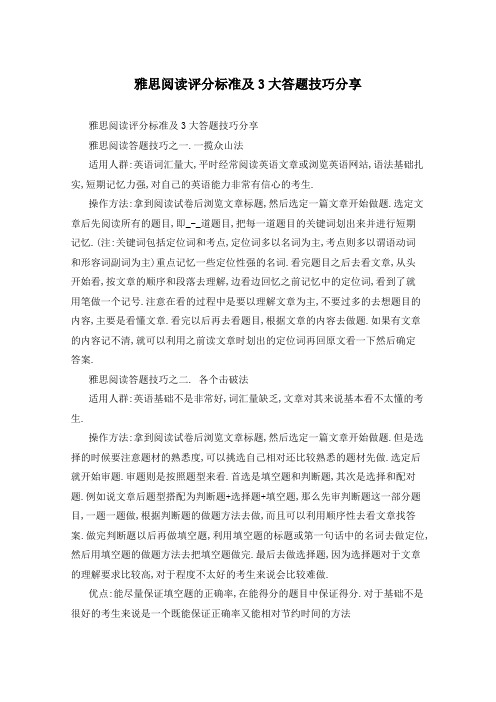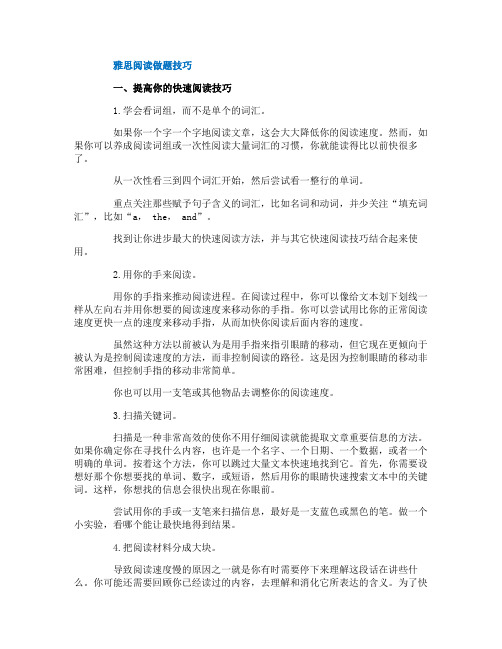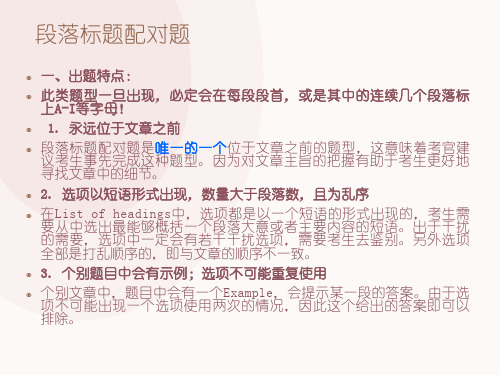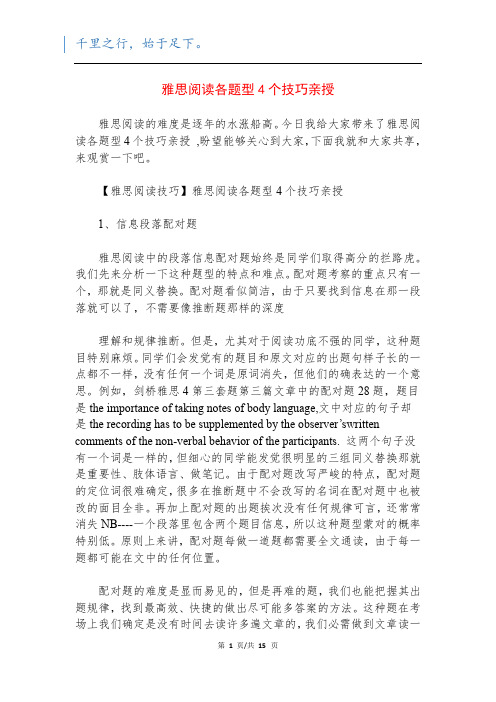雅思阅读题的3大技巧全总结
雅思阅读评分标准及3大答题技巧分享

雅思阅读评分标准及3大答题技巧分享雅思阅读评分标准及3大答题技巧分享雅思阅读答题技巧之一.一揽众山法适用人群:英语词汇量大,平时经常阅读英语文章或浏览英语网站,语法基础扎实,短期记忆力强,对自己的英语能力非常有信心的考生.操作方法:拿到阅读试卷后浏览文章标题,然后选定一篇文章开始做题.选定文章后先阅读所有的题目,即_-_道题目,把每一道题目的关键词划出来并进行短期记忆.(注:关键词包括定位词和考点,定位词多以名词为主,考点则多以谓语动词和形容词副词为主)重点记忆一些定位性强的名词.看完题目之后去看文章,从头开始看,按文章的顺序和段落去理解,边看边回忆之前记忆中的定位词,看到了就用笔做一个记号.注意在看的过程中是要以理解文章为主,不要过多的去想题目的内容,主要是看懂文章.看完以后再去看题目,根据文章的内容去做题.如果有文章的内容记不清,就可以利用之前读文章时划出的定位词再回原文看一下然后确定答案.雅思阅读答题技巧之二. 各个击破法适用人群:英语基础不是非常好,词汇量缺乏,文章对其来说基本看不太懂的考生.操作方法:拿到阅读试卷后浏览文章标题,然后选定一篇文章开始做题.但是选择的时候要注意题材的熟悉度,可以挑选自己相对还比较熟悉的题材先做.选定后就开始审题.审题则是按照题型来看.首选是填空题和判断题,其次是选择和配对题.例如说文章后题型搭配为判断题+选择题+填空题,那么先审判断题这一部分题目,一题一题做,根据判断题的做题方法去做,而且可以利用顺序性去看文章找答案.做完判断题以后再做填空题,利用填空题的标题或第一句话中的名词去做定位,然后用填空题的做题方法去把填空题做完.最后去做选择题,因为选择题对于文章的理解要求比较高,对于程度不太好的考生来说会比较难做.优点:能尽量保证填空题的正确率,在能得分的题目中保证得分.对于基础不是很好的考生来说是一个既能保证正确率又能相对节约时间的方法缺陷:时间花费比较多,而且会多次重复阅读文章.雅思阅读答题技巧之三. 融会贯通法适用人群:有一定的英语词汇量,并参加过培训班,掌握了基础语法知识.操作方法:拿到阅读试卷后浏览文章标题和文章后的题型,选择自己最熟悉的话题或者有自己最擅长的题型的那篇文章.然后浏览一下题型,确定下题型关注的先后顺序,也是先填空判断,后配对选择.但这种先后并不是绝对的,而是交替的,也就是在重点做填空判断之前已经将判断选择的定位词和关键词划出并记忆,然后在做填空判断时顺带着看看有没有出现配对题和选择题的定位词出现.如果程度稍好的同学则可以看一段文章,把这段文章中涉及到的各种题型的题目都完成,一段一段解决问题.但是用这种方法的时候要注意时间的把握.优点:可以相对合理的安排时间去做题,也能保证容易做的题型的正确率.缺陷:需要考生能随机应变,对不同的题型搭配要有合理的时间分配,可能会造成审题或看文章内容的混乱.附雅思阅读听力评分标准镇楼雅思阅读小范围预测文章题目Undergraduate students study dramas重复年份__31 _1_8题材人文社科题型暂无文章大意文学专业学生的课程指南,提到了让学生观看英国不同时期剧院中的戏剧, 并列举了不同时期四种剧院的特点.参考阅读:Medieval periodMain article: Medieval theatreBy the medieval period, the mummers plays had developed, a form of earlystreet theatre associated with the Morris dance, concentrating on themes such asSaint George and the Dragon and Robin Hood. These were folk tales re-telling oldstories, and the actors travelled from town to town performing these for theiraudiences in return for money and hospitality.Renaissance: Elizabethan and Jacobean periodsThe period known as the English Renaissance, appro_imately _00—_60, saw aflowering of the drama and all the arts. The two candidates for the earliestcomedy in English Nicholas Udall s Ralph Roister Doister (c. _52) and theanonymous Gammer Gurton s Needle (c. _66), belong to the _th century. Duringthe reign of Elizabeth I (_58–__) and then James I (__–25), in the late_th and early _th century, a London-centred culture, that was both courtly andpopular, produced great poetry and drama. The English playwrights were intriguedby Italian model: a conspicuous community of Italian actors had settled inLondon. The linguist and le_icographer John Florio (_53–_25), whose father wasItalian, was a royal language tutor at the Court of James I, and a possiblefriend of and influence on William Shakespeare, had brought much of the Italianlanguage and culture to England. He was also the translator of Montaigne intoEnglish. The earliest Elizabethan plays includes Gorboduc (_61) by Sackvilleand Norton and Thomas Kyd s (_58–94) revenge tragedy The Spanish Tragedy(_92), that influenced Shakespeare s Hamlet._th and _th centuriesAphra Behn was the first professional English woman playwright.During the Interregnum _49—_60, English theatres were kept closed by thePuritans for religious and ideological reasons. When the London theatres openedagain with the Restoration of the monarchy in _60, they flourished under thepersonal interest and support of Charles II. Wide and socially mi_ed audienceswere attracted by topical writing and by the introduction of the firstprofessionalactresses (in Shakespeare s time, all female roles had been played by boys).New genres of the Restoration were heroic drama, pathetic drama, and Restorationcomedy. Notable heroic tragedies of this period include John Dryden s All forLove (_77) and Aureng-zebe (_75), and Thomas Otway s Venice Preserved (_82).The Restoration plays that have best retained the interest of producers andaudiences today are the comedies, such as George Etherege s The Man of Mode(_76), William Wycherley s The Country Wife (_76), John Vanbrugh s The Relapse(_96), and William Congreve s The Way of the World (_00). This period saw thefirst professional woman playwright, Aphra Behn, author of many comediesincluding The Rover (_77). Restoration comedy is famous or notorious for itsse_ual e_plicitness, a quality encouraged by Charles II (_60–_85) personallyand by the rakish aristocratic ethos of his court.Victorian eraA change came in the Victorian era with a profusion on the London stage offarces, musical burlesques, e_travaganzas and comic operas that competed withShakespeare productions and serious drama by the likes of James Planché andThomas William Robertson. In _55, the German Reed Entertainments began aprocess of elevating the le vel of (formerly risqué) musical theatre in Britainthat culminated in the famous series of comic operas by Gilbert and Sullivan andwere followed by the _90s with the first Edwardian musical comedies. W. S.Gilbert and Oscar Wilde were leading poets and dramatists of the late Victorianperiod.[_] Wilde s plays, in particular, stand apart from the many nowforgotten plays of Victorian times and have a much closer relationship to thoseof the Edwardian dramatists such as Irishman George Bernard Shaw and NorwegianHenrik Ibsen.文章题目Unique golden te_tile重复年份___ ___题材工业题型小标题 6+人名配对 4+填空 3文章大意蜘蛛丝与纺织品.文章讲述了 golden spider 是如何在体内把Liquid silk转化为 solid silk 的过程,文章中提到了一些科学家针对蜘蛛做的实验,如何提高 capacity.在结尾两段讲述了关于 spider silk的医学应用及市场的积极前景.参考答案:小标题:i e_periment of an old ideaii lifecycle of Madagascar spidersiii advances in te_tile industryiv resources to meet demandsv physical property of spider silkvi scientific analysis spider silkvii work of artviii importance of silk te_tilei_ difficult to raise spider in capacity_. Paragraph A viii_. Paragraph B v_. Paragraph C i__. Paragraph Di_. Paragraph E iv_. Paragraph F vii人名配对 4:A. Simon PeersB. Nicholas GodlleyC. Blackledge20. need tremendous spider to make a small amount of spider silk B _ Scientists want qualities of spider silk for medical use A_ Scientists make progress to manufacture spider silk C23 spider silk materials are be of strength A填空 3:24. grow silk by introduce genetic material into bacteria and animals25. Silk come from liquid protein made in a gland inside of bodies.26. Spider silk spins cause force to make liquid turn to solid silk.文章题目 British Woodlands重复年份 __30 ___题材自然环境题型段落细节配对 7+选词填空 7文章大意讲的是英国森林的演变利用和最后的管理,大致文章脉络是在人类的入侵之前英国的植被覆盖情况,工业革命之后,人们对森林的掠夺从以燃烧原料和建筑材料为目的到了以工业发展为目的,后来人们意识到保护森林的重要, 开始投入人力物力进行保护.部分答案参考:段落细节配对:27 a desc ription of careless working practices that harm woodland F28 details of landscape prior to human intervention B29 arguments against cash rewards H30 a botanical source of evidence for the appearance of primitive woodlandB31 reasons for reduced economic importance of woodland E32 a reason for recent improvements of woodland management G33 an implication for people of unhealthy tree A选词填空:Evolution of British WoodlandWhen woodland started to grow after last Ice Age. certain 34. speciesnaturallydominated certain regions of Britain. People then intervened to reduce thewoodland by using grazing animals and methods such as 35. burning and coppicing.An increasing number of trees have been grown to meet the demand of 36.IndustrySituations of woodland in Britain deteriorated due to the use of 37.I andthe rigid38. planting patterns of woodland. Such practices also destroyed the39.habits Gof animals and other wildlife.However, in the twentieth century, the state of woodland in Britain has beenimproved. 40.grants available for fund encourage people to plant trees in goodquality.雅思阅读小范围预测题目:the nature of yawning内容:关于打哈欠传染的研究题型:段落细节匹配5道+特殊词匹配4道+填空4道题号:___文章大意:讲关于打呵欠传染的研究,主要有三个研究机构开展的研究.第一个机构研究发现打呵欠是人类冷却大脑的一种方式.后面两个研究发现打呵欠和个人的性格.同情心.专业背景有关,和性别无关.最后讲了呵欠产生的过程,提到有一种理论讲的是呵欠可能是人类交流的一种方式,用于提醒同伴你累了需要休息,从而要求对方打起精神应对危险.部分答案回忆:_. C imagining leads to yawning_. D occupation and inclination to yawning_. A overview of research_. B body temperature and yawning_. B disapprove of a theory_. B not difference in gender20. C mental disorder 文中定位:autism_. A the way we breathe 文中定位:inhale_. B trained yawn more than the untrained23. bond用来联系人类情感24 danger危险的时候警示别人rest特别是需要休息的时候non-verbal是人类肢体语言的一种题目:the nature of music内容:对音乐的研究,介绍音乐历史和音乐对人类的影响题型:选择4道+段落信息匹配5道+判断5道参考答案:25. C定位词:第一段中的 nature of music ,答案:many elements26. D 定位词:language and music ,答案:STEVE27. A 定位词:Neanderthals 答案:show reactions28. C定位词:Neanderthals and homo sapiens 答案:for partners31 . D 定位词:feature and music ,答案:change in all cultures32. C 定位词:Mithen ,答案:reference for other people33. A定位词:precious research ,答案:limited in the range of research34. E 定位词:power of emotion ,答案:long history35. B 定位词:reviewer disagrees with Mithen ,答案:modem speech 影响音乐36. TRUE most discussion ignore physical factors37. TRUE shared features/small societies/remote areas38. NOT GIVEN people talk to babies/similar to/Neandethals music39. FALSE Mithen support Steve40. NOT GIVEN modem people depend heavily on electronic music题目:Thomas Young ~The Last True Know一It一All题材:人物传记题型:判断7+填空6参考文章:A Thomas Young(_73一_29)contributed 63 articles to the EncyclopediaBritannica, Including 46 Biographical entries(mostly on scientists andclassicists) and substantial essays on Bridge, Chromatics, Egypt, Languages,and Tides Was someone who could write authoritatively about so many subjects apolymath, a genius or a dilettante? In an ambitious new biography, Andrew Robinson argues that Young is a good contender for the epitaph the lastman whoknew everything〞 Young has competition, however: The phrase, which Robinsontakes for his title, also serves as the subtitle of two other recentbiographies: Leonard Warren s _98 life of paleontologist Joseph Leidy(_23一_91) and Paula Findlen s _ book on Athanasius Kircher (__一_80),another polymath.B Young, of course, did more than write encyclopedia entries . He presentedhid first paper to the Royal Society of London at the age of 2O and was electeda Fellow a week after his 2lst birthday. In the paper, Young e_plained theprocess of accommodation in the human eye一on how the eye focuses properly onobjects at varying distances. Young hypothesized that this was achieved bychanges in the shape of the lens. Young also theorized that light traveled inwaves and he believed that, to account for the ability to see in color, theremust be three receptors in the eye corresponding to the three principal colorsto which the retina could respond: red, green, violet. All these hypotheses weresubsequently proved to be correct.C Later in his life, when he was in his forties, Young was instrumental incracking the code that Unlocked the unknown sc ript on the Rosetta Stone,atablet that was found in Egypt by the Napo leonic army in_99.The stonecontains te_t in three alphabets: Greek, something Unrecognizable and Egyptianhieroglyphs. The unrecognizable sc ript is now known as demotic and, as Youngdeduced, is related directly to hieroglyphic. His initial work on this appearedin his Britannica entry on Egypt. In another entry, he coined the termIndo一European to describe the family of languages spoken throughout most ofEurope and northern India. These are the landmark achievements of a man who wasa child prodigy and who,unlike many remarkable children, did not disappear intooblivion as an adult.D Bom in _73 in Somerset in England, Young lived from an early age with hismaternal Grandfather ,eventually leaving to attend boarding school. He haddevoured books from the age of two, and through his own initiative hee_celledat Latin, Greek, mathematics and natural philosophy. After leaving school , hewas greatly encouraged by his mother s uncle, Richard Brocklesby, a physicianand Fellow of the Royal Society. Following Brocklesby lead, Young decided topursue a career in medicine. He studied in London, following the medicalcircuit, and then moved on to more formal education in Edinburgh, G6ttingen andCambridge. After completing his medical training at the University of Cambridgein __, Young set up practice as a physician in London. He soon became a Fellowof the Royal College of Physicians and a few years later was appointed physicianat St. George’s Hospital.E Young’s skill as a physician, however, did not equal his skill as a scholarof natural philosophy or linguistics. Earlier, in __, he had been appointed toa professorship of natural philosophy at the Royal Institution, where hedelivered as many as 60 lectures in a year. These were published in two volumesin __. In __ Young had become secretary to the Royal Society, a post hewould hold until his death. His opinions were sought on civic and nationalmatters, such as the introduction of gas lighting to London and methods of shipconstruction. From __ he was superintendent of the Nautical Almanac andsecretary to the Board of Longitude. From _24 to _29 he was physician to andinspector of calculations for the Palladian Insurance Company. Between __ and_25 he contributed his many and various entries to the Encyclopedia Britannica,and throughout his career he authored numerous books, essays and papers.F Young is a perfect subject for a biography - perfect, but dauntitianhieroglyphs). Some readers of this book will, like Robinson, find Young’saccomplishments impressive; others will see him as some historians have - as adilettante. Yet despite the rich material presented in this book, readers willnot end up knowing Young personally. We catch glimpses of a playful Young,doodling Greek and Latin phrases in his notes on medical lectures and translating the verses that a young lady had written on the walls of a summerhouse into Greek elegiaes. Young was introduced into elite society,attended the theatre and learned to dance and play the flute. In addition, hewas an accomplished horseman. However, his personal life looks pale ne_t to hisvibrant career and studies.G Young married Eliza Ma_well in __, and according to Robinson, theirmarriage was a happy one and she appreciated his work_ Almost all we know abouther is that she sustained her husband through some rancorous disputes aboutoptics and that she worried about money when his medical career was slow to takeoff. Veiy little evidence survives about the comple_ities of Young5s relationships with his mother and father. Robinson does not credit them,oranyone else, with shaping Young5 s e_traordinary mind. Despite the lack ofdetails concerning Young5 s relationships, however, anyone interested in what itmeans to be a genius should read this book.参考答案:Questions 1-7Do the following statements agree with the information given in ReadingPassage 1 ?In bo_es 1 -7 on your answer sheet, write TRUE if the statement is true FALSEif the statement is falseNOT GIVEN if the information is not given in the passage1 The last man who knew everything’ has also been claimed to other people.True2 All Young articles were published in Encyclopedia Britannica. False3 Like others, Young wasn’t so brilliant when grew up. False4 Young talents as a tor are surpassing his other skills. NG5 Young advice was sought by people responsible for local and nationalissues. True6 Young was interested in various social pastimes. True7 Young suffered from a disease in his later years. NGQuestions 8-_Answer the questions below.Choose NO MORE THAN THREE WORDS AND/OR A NUMBER from the passage for eachanswer.8 How many life stories did Young write for Encyclopedia Britannica?469 What aspect of scientific research did Young do in his first academicpaper? Human eye accommodation10 What name did Young introduce to refer to a group of languages?Indo-European_ Who inspired Young to start the medical studies? Richard Brocklesby _ Where did Young get a teaching position? Royal Institution_ What contribution did Young make to London? Gas lighting 雅思阅读评分标准及3大答题技巧分享。
雅思阅读选词填空

雅思阅读选词填空雅思阅读选词填空题是雅思阅读中的一个常见题型,要求考生从一段文章中选出正确的单词或词组填入空格中。
该题型考察考生对文章的理解能力以及词汇掌握能力。
以下是针对该题型的一些解题技巧和注意事项:一、解题技巧:1. 先读题目要求,理清思路:选择正确的单词或短语填空。
2. 精读文章,先不填空:对于选词题,每段短文都会有一部分字眼留白,现在首先要做的是全文浏览,找出文章的大意,因为每个空后面都会有一些提示信息如:participle或者是数字,或是一些连词,所以需要把每个空前后的句子好好阅读。
3. 使用上下文引导:在对文章进行精读后,我们可以按照空格的位置逐个填写相应的单词,但是如果看不懂这个单词究竟应该填哪个,那么就可以利用上下文的线索进行判断。
4. 复合词照顾:空格中的单词很有可能是复合词,所以要留意复合词中的各个部分,以便正确填入空格。
二、注意事项:1. 注意单复数:有些空格中需要填写复数名词,而有些则需要单数形式的名词,所以不仅要注意选对名词,还要认真查看是否需要加上-s等后缀。
2. 关注时态:有些空格需要填写动词,而且还必须是某个特定的时态形式,因此尤其要注意时态。
3. 考虑搭配:对于同意义的单词,它们的搭配可能不一样,因此需要仔细考虑哪个词更适合配合上下文,才能填写正确的答案。
4. 注意名词性物主代词:有些时候空格中需要填写物主代词,但是要根据上下文判断所填写代词是主格还是宾格,还要注意其单复数形式。
总而言之,在解答选词填空的题目时,需要在整体把握文章内容的同时,也要注意到一些细节,然后根据上下文进行推测和判断,因为不要相信言过其实构成的顺口溜——“选词填空,不会会空,会了也不会准”,而是尽量的在实践中提高我们的解决问题的能力,这样才能更高效、更准确的解答这类题目。
雅思阅读技巧总结

雅思阅读技巧总结
《雅思阅读技巧总结》
嘿呀,说到雅思阅读啊,那可真是有点门道的哟!
我记得有一次我做雅思阅读练习的时候,那篇文章简直像个迷宫一样。
我就像个没头苍蝇似的在里面乱撞。
哎呀,那密密麻麻的单词,看得我头都大了。
这时候我就意识到一些技巧的重要性啦。
首先呢,咱得学会快速浏览题目,就像找宝藏的线索一样,得先知道要找啥。
然后呢,读文章的时候可不能一个字一个字地死磕,那得抓关键信息呀,就像在一堆杂草里找到那几朵漂亮的小花。
还有哦,遇到生词别慌,咱就大胆地猜一猜,结合上下文说不定就能明白个大概意思呢。
可别被那些生词吓住了,咱得有勇气和它们斗一斗。
再有就是要注意时间管理呀,别在一道题上纠结太久,不然时间一下子就没啦。
就像赶火车似的,得抓紧时间,该上就上,别磨蹭。
总之呢,雅思阅读虽然有点难搞,但只要我们掌握了这些小技巧,就像是有了一把钥匙,能打开那扇通往高分的大门哟!以后再遇到雅思阅读,我可就不会像那次一样手忙脚乱啦,我要淡定从容地应对,把那些难题都给搞定!嘿嘿,加油吧!。
雅思阅读做题技巧有哪些

雅思阅读做题技巧一、提高你的快速阅读技巧1.学会看词组,而不是单个的词汇。
如果你一个字一个字地阅读文章,这会大大降低你的阅读速度。
然而,如果你可以养成阅读词组或一次性阅读大量词汇的习惯,你就能读得比以前快很多了。
从一次性看三到四个词汇开始,然后尝试看一整行的单词。
重点关注那些赋予句子含义的词汇,比如名词和动词,并少关注“填充词汇”,比如“a, the,and”。
找到让你进步最大的快速阅读方法,并与其它快速阅读技巧结合起来使用。
2.用你的手来阅读。
用你的手指来推动阅读进程。
在阅读过程中,你可以像给文本划下划线一样从左向右并用你想要的阅读速度来移动你的手指。
你可以尝试用比你的正常阅读速度更快一点的速度来移动手指,从而加快你阅读后面内容的速度。
虽然这种方法以前被认为是用手指来指引眼睛的移动,但它现在更倾向于被认为是控制阅读速度的方法,而非控制阅读的路径。
这是因为控制眼睛的移动非常困难,但控制手指的移动非常简单。
你也可以用一支笔或其他物品去调整你的阅读速度。
3.扫描关键词。
扫描是一种非常高效的使你不用仔细阅读就能提取文章重要信息的方法。
如果你确定你在寻找什么内容,也许是一个名字、一个日期、一个数据,或者一个明确的单词。
按着这个方法,你可以跳过大量文本快速地找到它。
首先,你需要设想好那个你想要找的单词、数字,或短语,然后用你的眼睛快速搜索文本中的关键词。
这样,你想找的信息会很快出现在你眼前。
尝试用你的手或一支笔来扫描信息,最好是一支蓝色或黑色的笔。
做一个小实验,看哪个能让最快地得到结果。
4.把阅读材料分成大块。
导致阅读速度慢的原因之一就是你有时需要停下来理解这段话在讲些什么。
你可能还需要回顾你已经读过的内容,去理解和消化它所表达的含义。
为了快速阅读,你可以尝试只在每一个阅读阶段结束时停下来,或者在每个阅读部分或章节结束的时候停下来思考。
在每个快速阅读阶段结束后确认自己是否理解阅读内容,你可以写下这段阅读的关键词,用几句话总结这段阅读材料,或者尝试向别人解释这段阅读内容。
雅思阅读heading

d. 中心句在分散在段落中(A+B)
有些段落的段落大意仅根据一句话并不能判断出来, 需要抓住文章中的两句甚至几句中心句。这种段落 往往会有并列结构,如also, in addition, furthermore等。
例12 Agriculture consumes about 70% of the world’s fresh water, so improvements in irrigation can make the greatest impact. … After agriculture, industry is the second biggest user of water… (剑6, G类Test A, Section 3)
下面将为大家介绍中心句出现的常见的几种类型:
a. 中心句在第一句
绝大多数的英语文章均采用演绎法(deductive method) 来写,也就是先出中心句,然后再写支持细节(supporting details)。这个时候,判断的标准就是看第二句话是否是 支持细节。支持细节经常会有以下特征: a) 有举例信号词:For example, for instance, sometimes, often等。 b) 有专有名词,如人名、地名等。
二、 解题步骤
1. 浏览文章
专家建议考生,如果文章有标题、副标题、图片、 小标题,则必须在做题之前仔细进行阅读,因为这 些内容往往暗示了文章的主题,这对于考生把握全 文大意、排除干扰选项会有一定的帮助。
2. 划掉示例中的选项
由于选项不可能被重复使用,因此Example中的选 项不可能再次出现,故没有必要浪费时间去阅读这 部分内容。所以直接在这个选项上划叉即可。另外, 对于某些记忆力不好的考生来说,也可以把这个选 项所对应的段落做上记号,以免误读从而浪费时间。
雅思阅读各题型4个技巧亲授

雅思阅读各题型4个技巧亲授雅思阅读的难度是逐年的水涨船高。
今日我给大家带来了雅思阅读各题型4个技巧亲授,盼望能够关心到大家,下面我就和大家共享,来观赏一下吧。
【雅思阅读技巧】雅思阅读各题型4个技巧亲授1、信息段落配对题雅思阅读中的段落信息配对题始终是同学们取得高分的拦路虎。
我们先来分析一下这种题型的特点和难点。
配对题考察的重点只有一个,那就是同义替换。
配对题看似简洁,由于只要找到信息在那一段落就可以了,不需要像推断题那样的深度理解和规律推断。
但是,尤其对于阅读功底不强的同学,这种题目特别麻烦。
同学们会发觉有的题目和原文对应的出题句样子长的一点都不一样,没有任何一个词是原词消失,但他们的确表达的一个意思。
例如,剑桥雅思4第三套题第三篇文章中的配对题28题,题目是the importance of taking notes of body language,文中对应的句子却是the recording has to be supplemented by the observer’swritten comments of the non-verbal behavior of the participants. 这两个句子没有一个词是一样的,但细心的同学能发觉很明显的三组同义替换那就是重要性、肢体语言、做笔记。
由于配对题改写严峻的特点,配对题的定位词很难确定,很多在推断题中不会改写的名词在配对题中也被改的面目全非。
再加上配对题的出题挨次没有任何规律可言,还常常消失NB----一个段落里包含两个题目信息,所以这种题型蒙对的概率特别低。
原则上来讲,配对题每做一道题都需要全文通读,由于每一题都可能在文中的任何位置。
配对题的难度是显而易见的,但是再难的题,我们也能把握其出题规律,找到最高效、快捷的做出尽可能多答案的方法。
这种题在考场上我们确定是没有时间去读许多遍文章的,我们必需做到文章读一遍,全部的题目就处理完了。
雅思阅读第三篇技巧

雅思阅读第三篇技巧
雅思阅读第三篇是难度较大的一篇,因此需要掌握一些技巧来提高阅读效率和准确率。
以下是一些可能有用的技巧:
1. 确定主题和结构:在开始阅读之前,先确定文章的主题和结构,有助于更好地理解文章内容。
主题可以通过文章标题或第一段来确定,结构可以通过段落标题或小标题来确定。
2. 快速浏览全文:在开始阅读细节之前,快速浏览全文可以了解文章的大意和主要内容,有助于更好地把握文章的重点。
3. 寻找关键词和主题句:在阅读过程中,要注意寻找关键词和主题句,这些词句可以帮助你更好地理解段落的大意。
4. 掌握阅读技巧:掌握一些阅读技巧,如略读、跳读、猜测词义等,可以帮助你更快地阅读和理解文章。
5. 注意细节信息:在阅读过程中,要注意细节信息,这些信息可能对于回答问题非常重要。
6. 多练习:通过大量的练习来提高阅读速度和理解能力,是提高雅思阅读成绩的重要技巧之一。
希望以上技巧对你有帮助。
祝你考试顺利!。
雅思阅读填空题做题步骤-出题特点-答题技巧

雅思阅读填空题做题步骤-出题特点-答题技巧雅思阅读填空的做题步骤有这些:第一步:巧用连词、冠词和介词进行猜测;第二步:定位,利用定段→定句→定词的三步原理,快速找到答案所在位置。
第一步:巧用连词、冠词和介词进行猜测在填空题中,这些词能帮你猜测可能出现的答案,并在原文中进行定位。
连词主要关注空格前后有没有“and〞,“but〞和“as a result〞。
这三个词分别表示并列、转折和因果关系,可以帮你猜测答案可能的词性。
冠词主要是a,an,the,可帮你初步推断答案是单数还是复数,并且接在冠词后面的答案一般会是名词。
介词则分为几种,按构词分类的话,有:简单介词 in,on,with,by,for,at,about,under 等。
合成介词 into,onto,without,within 等。
堆叠介词 from among,until after,at about 等。
介词短语和分词介词ing。
通常在介词后面填空,也会接名词,并且还能猜测是表示方位、时间等性质的名词。
第二步:定位如果通读全文来找填空题答案,费时费力。
大家可以通过定段→定句→定词的三步原理,快速找到答案所在位置。
首先大家要知道填空题段与段之间一定是按顺序来的,所以如果你上一个答案已经找到具体段落,那么下一个答案一定不会出现在这个段落之前的段落。
但是段落内可能会有乱序,所以定句就不能按顺序来进行。
另外大家可以依据填空题中某些定位词来定位具体段落,定位词的顺序依次是:特别名词名词动词形容词。
这个顺序是按照不可替换程度来排序,越特别名词越不容易被替换,一眼就能被识别出。
一般特别名词包括人名、具体地点名字以及特别物品名称。
比如一个特别人群叫做Lapita,这是一个专有名词,没法进行替换,所以能够一眼在文中找到它。
再结合答案前后语句,找到文中具体句子,就能定位具体单词了。
2雅思阅读选择题出题特点(1) 细节型题目。
选择题除了位于题目末尾的全篇主旨题和title题考查考生对全文大意的理解外,主要考查的是考生对细节信息的定位和理解,也就是说,考生依据题干信息在原文中找到相关信息,只要精读该部分信息即可确定答案。
- 1、下载文档前请自行甄别文档内容的完整性,平台不提供额外的编辑、内容补充、找答案等附加服务。
- 2、"仅部分预览"的文档,不可在线预览部分如存在完整性等问题,可反馈申请退款(可完整预览的文档不适用该条件!)。
- 3、如文档侵犯您的权益,请联系客服反馈,我们会尽快为您处理(人工客服工作时间:9:00-18:30)。
雅思阅读题的3大技巧全总结做雅思阅读的时候学会总结很重要,今天给大家带来了雅思阅读题的3大技巧全总结,希望能帮助到大家,下面就和大家分享,来欣赏一下吧。
阅读大作战雅思阅读题的3大技巧全总结第一,积累一定的词汇量。
大家要正确认识和有效提高词汇量。
建议同学们根据考试选材的常见类别进行相应的专题复习,并运用一定的记单词的技巧,单词量是可以在短期内有效提高的。
另外,虽然很多同学的单词量还行,但是单词的词形却没有分清楚,虽然说词形对考试来说不是很重要,但是请大家也不要忽略这个问题,在记单词的时候大家多留点心就把词形的问题解决了。
第二,熟悉背景知识。
从语言学的角度来看,雅思阅读其实考察的也有背景知识,建议大家多看看国家地理,探索频道,BBC 等节目,多积累一些知识,结合考试的常见题材加以学习,若能持之以恒,必有达成。
第三,熟悉语法。
语法就相当于英语的经络,如果经脉不通,隐藏的病症就会郁积的越厉害,发作之时如燎原之势必然一发不可收拾。
没有语法的词汇就像是脱缰的野马,散落的珍珠,无法够成一个有力的整体,发挥不了原有的效力,希望大家能够活用语法,判断清楚句子的主谓宾,仔细分析句子的结构。
雅思考试阅读模拟练习及答案Don’t wash those fossils!Standard museum practice can wash away DNA.1. Washing,brushing and varnishing fossils — all standard conservation treatments used by many fossil hunters and museum curators alike — vastly reduces the chances of recovering ancient DNA.2. Instead,excavators should be handling at least some of their bounty with gloves,and freezing samples as they are found,dirt and all,concludes a paper in the Proceedings of the National Academy of Sciences today.3. Although many palaeontologists know anecdotally that this is the best way to up the odds of extracting good DNA,Eva-Maria Geigl of the Jacques Monod Institute in Paris,France,and her colleagues have now shown just how important conservation practices can be. This information,they say,needs to be hammered home among the people who are actually out in the field digging up bones.4. Geigl and her colleagues looked at 3,200-year-old fossil bones belonging to a single individual of an extinct cattle species,called an aurochs. The fossils were dug up at a site in France at two different times — either in 1947,and stored in a museum collection,or in 2004,and conserved in sterile conditions at -20 oC.5. The team’s attempts to extract DNA from the 1947 bones all failed. The newly excavated fossils,however,all yielded DNA.6. Because the bones had been buried for the same amount of time,and in the same conditions,the conservation method had to be to blame says Geigl. “As much DNA was degraded in these 57 years as in the 3,200 years before,” she says.Wash in,wash out7. Because many palaeontologists base their work on the shape of fossils alone,their methods of conservation are not designed to preserve DNA,Geigl explains.8. The biggest problem is how they are cleaned. Fossils are often washed together on-site in a large bath,which can allow water — and contaminants in the form of contemporary DNA — to permeate into the porous bones. “Not only is the authentic DNAgetting washed out,but contamination is getting washed in,” says Geigl.9. Most ancient DNA specialists know this already,says Hendrik Poinar,an evolutionary geneticist at McMaster University in Ontario,Canada. But that doesn’t mean that best practice has become widespread among those who actually find the fossils.10. Getting hold of fossils that have been preserved with their DNA in mind relies on close relationships between lab-based geneticists and the excavators,says palaeogeneticist Svante P bo of the Max Planck Institute for Evolutionary Anthropology in Leipzig,Germany. And that only occurs in exceptional cases,he says.11. P bo’s team,which has been sequencing Neanderthal DNA,continually faces these problems. “When you want to study ancient human and Neanderthal remains,there’s a big issue of contamination with contemporary human DNA,” he says.12. This doesn’t me an that all museum specimens are fatally flawed,notes P bo. The Neanderthal fossils that were recently sequenced in his own lab,for example,had been part of a museum collection treated in the traditional way. But P bo is keento see samples of fossils from every major find preserved in line with Geigl’s recommendations — just in case.Warm and wet13. Geigl herself believes that,with cooperation between bench and field researchers,preserving fossils properly could open up avenues of discovery that have long been assumed closed.14. Much human cultural development took place in temperate regions. DNA does not survive well in warm environments in the first place,and can vanish when fossils are washed and treated. For this reason,Geigl says,most ancient DNA studies have been done on permafrost samples,such as the woolly mammoth,or on remains sheltered from the elements in cold caves — including cave bear and Neanderthal fossils.15. Better conservation methods,and a focus on fresh fossils,could boost DNA extraction from more delicate specimens,says Geigl. And that could shed more light on the story of human evolution.(640 words nature )GlossaryPalaeontologists 古生物学家Aurochs 欧洲野牛Neanderthal (人类学)尼安德特人,旧石器时代的古人类。
